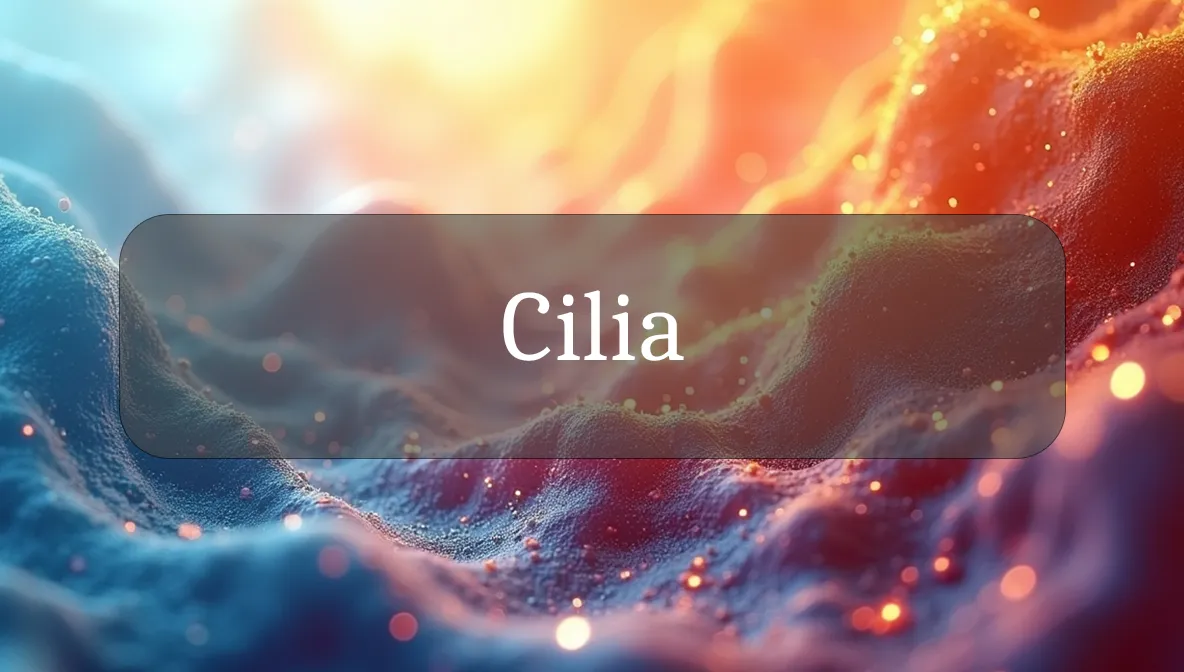Tiny Hairs Keeping Your Body in Motion and Balance
Cilia are like the delicate, waving hairs on your cells, working tirelessly to keep your airways clear, your senses sharp, and your organs functioning smoothly. These microscopic, hair-like structures extend from cell surfaces, moving fluids, trapping debris, or sensing signals to support your overall wellness. For health-conscious folks eager to optimize their vitality, understanding cilia can unlock insights into how your body stays clean, connected, and healthy. Let’s dive into what cilia are, why they’re vital for your health, and how to support their function for a thriving you.
Identity and Function
Cilia are slender, hair-like cellular structures, or organelles, protruding from the surface of many cells in your body. Made of microtubules (tiny protein tubes) arranged in a “9+2” pattern, they’re anchored by basal bodies and powered by motor proteins. Cilia come in two types: motile cilia, which beat rhythmically to move fluids or particles (like in your lungs), and primary cilia, which act like antennas, sensing body signals (like in your kidneys). They’re critical for movement, sensing, and cell communication [1].
Biological Role and Health Impact
Cilia are the multitaskers of your cells, with a profound impact on your health:
- Airway Protection: Motile cilia in your lungs and sinuses sweep out mucus, dust, and germs, preventing infections and keeping breathing easy [2].
- Sensory Function: Primary cilia in eyes, ears, and nose detect light, sound, or chemical signals, sharpening your senses and balance [1].
- Fluid Movement: Cilia in kidneys, brain, and reproductive tracts move fluids to prevent blockages, support brain health, or aid fertility [3].
- Cell Signaling: Primary cilia receive body signals for growth, repair, or organ balance, acting like cellular GPS [4].
- Health Implications: Faulty cilia cause ciliopathies, like primary ciliary dyskinesia (chronic lung infections) or polycystic kidney disease (kidney cysts). Cilia defects may also contribute to obesity or cancer if signaling goes off track [5].
Healthy cilia keep your lungs clear, your organs flowing, and your body in tune, supporting vibrant health.
Supporting Health
Cilia are part of your cells, not consumed, but you can nurture their environment to keep them thriving:
- Balanced Diet: Proteins (e.g., fish, eggs) provide amino acids for microtubule production, while zinc supports cilia structure [2].
- Hydration: Water keeps mucus thin and cilia moving smoothly, especially in airways [3].
- Sleep and Recovery: Adequate rest (7–8 hours nightly) allows cells to repair cilia, particularly in lungs and sensory organs [4].
- Exercise: Regular activity (e.g., cardio or deep breathing) boosts lung health and fluid flow, supporting cilia function [1].
Signs of Dysfunction
Cilia problems are rare but can disrupt health:
- Dysfunction Signs:
- Chronic cough, sinus infections, or bronchitis (from immobile airway cilia) [2].
- Kidney issues, infertility, or brain fluid buildup (from impaired fluid-moving cilia) [3].
- Vision, hearing, or balance problems (from defective sensory cilia) [4].
- Causes: Genetic mutations, nutrient deficiencies (e.g., protein or zinc), or toxins like air pollutants can damage cilia [5].
- Disease Link: Ciliopathies (e.g., Kartagener’s syndrome) cause widespread issues, while cilia defects may fuel cancer or obesity [4].
If you notice persistent respiratory, sensory, or organ issues, consult a doctor, as these may signal cilia-related problems.
Promoting Optimal Function
You can support your cilia with practical, everyday habits:
- Eat Protein-Rich Foods: Aim for 0.8–1.2 g of protein per kg of body weight daily (e.g., chicken, lentils) to supply amino acids for cilia’s microtubules [2].
- Include Zinc-Rich Foods: Oysters, seeds, or beef provide zinc to strengthen cilia and support their movement [1].
- Boost Antioxidants: Berries, spinach, or carrots offer cell protectors to shield cilia from stress or pollutant damage [3].
- Stay Active: Practice deep breathing, brisk walking, or swimming (150 minutes weekly) to enhance lung cilia and fluid flow in organs [4].
- Limit Toxins: Avoid smoking, air pollution, or heavy metals (e.g., mercury in fish), which harm cilia—use air purifiers or filtered water if needed [5].
- Stay Hydrated: Drink 8–10 cups of water daily to keep mucus fluid, helping airway cilia sweep out debris [2].
- Prioritize Sleep: Get 7–8 hours of rest to allow cells to repair cilia, especially in lungs and kidneys [3].
No specific intake exists for cilia, as your cells produce them based on need, but a nutrient-rich lifestyle keeps them waving strong.
Safety and Stressors
Cilia are safe as natural cell components, but certain factors can stress them:
- Stressors:
- Nutrient Deficiencies: Lack of protein, zinc, or folate can impair cilia assembly, slowing their function [3].
- Toxins: Air pollutants, cigarette smoke, or heavy metals (e.g., lead) can paralyze or destroy cilia, especially in airways [5].
- Chronic Stress: High stress or poor sleep can hinder cell repair, affecting cilia performance [4].
- Safety Considerations:
- Genetic Conditions: Ciliopathies require medical care, not dietary fixes, and may need specialist monitoring [3].
- Environmental Toxins: Avoid secondhand smoke and test water for heavy metals to protect cilia health [5].
- Respiratory Health: Chronic exposure to dust or smog can damage airway cilia, so use masks in polluted areas [2].
- Who’s at Risk? Those with poor diets, genetic conditions, or exposure to pollutants may face higher risks of cilia issues.
Fun Fact
Cilia are like tiny synchronized swimmers! In your lungs, they beat up to 1,000 times per minute in perfect waves, clearing out germs like a choreographed dance team [1]!
Citations
- Alberts, B., et al. (2014). Molecular Biology of the Cell. Garland Science.
- National Library of Medicine. (2022). Cilia and Respiratory Health.
- Mayo Clinic. (2024). Kidney and Sensory Health.
- National Institutes of Health. (2023). Ciliopathies and Cell Signaling.
- Centers for Disease Control and Prevention (CDC). (2023). Environmental Toxins and Cellular Health.

